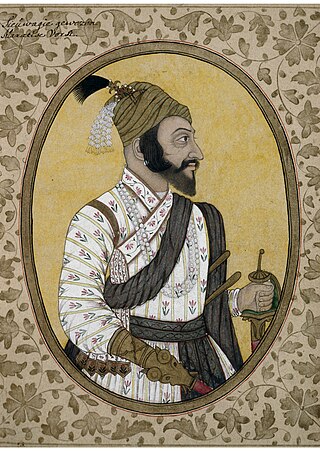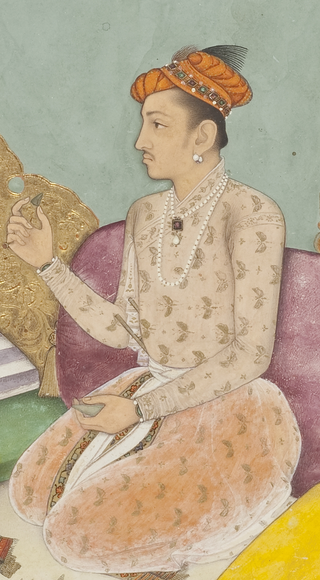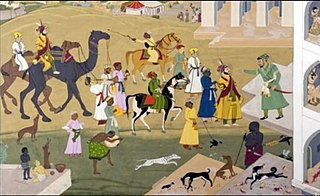
Shivaji I was an Indian ruler and a member of the Bhonsle dynasty. Shivaji carved out his own independent kingdom from the Sultanate of Bijapur that formed the genesis of the Maratha Confederacy. In 1674, he was formally crowned the Chhatrapati of his realm at Raigad Fort.

Sambhaji, also known as Shambhuraje, was the second Chhatrapati of the Maratha Kingdom, ruling from 1681 to 1689. He was the eldest son of Shivaji, the founder of the Maratha Kingdom. Sambhaji's rule was largely shaped by the ongoing wars between the Marathas and the Mughal Empire, as well as other neighbouring powers such as the Abyssinians of Janjira, Wadiyars of Mysore and the Portuguese Empire in Goa. After Sambhaji's execution by Aurangzeb, his brother Rajaram I succeeded him as the next Chhatrapati and continued the Mughal–Maratha Wars.

Shahaji Bhonsale was a 17th century Indian military leader who served the Ahmadnagar Sultanate, the Bijapur Sultanate, and the Mughal Empire at various points in his career. As a member of the Bhonsle dynasty, Shahaji inherited the Pune and Supe jagirs (fiefs) from his father Maloji, who previously served the Ahmadnagar Sultanate. During the Mughal invasion of the Deccan, Shahaji joined the Mughal forces and served under Emperor Shah Jahan for a short period. After being deprived of his jagirs, he defected to the Bijapur Sultanate in 1632 and regained control over Pune and Supe. In 1638, he received the jagir of Bangalore after Bijapur's invasion of Kempe Gowda III's territories. Afterwards, he became the chief general of Bijapur and oversaw its expansion.

Afzal Khan was a general who served the Adil Shahi dynasty of Bijapur Sultanate in India. He played an important role in the southern expansion of the Bijapur Sultanate by subjugating the Nayaka chiefs who had taken control of the former Vijayanagara territory.

Nashik district, formerly known as Nasik district, is a district in Maharashtra, India. The city of Nashik is the administrative headquarters of the district. Nashik is well known for the production of wine. Nashik is also known as Mini Maharashtra, because the climate and soil conditions of Surgana, Peth, Igatpuri resembles with Konkan. Niphad, Sinnar, Dindori, Baglan blocks are like Western Maharashtra and Yeola, Nandgaon, Chandwad blocks are like Vidarbha Region. Nashik is the biggest city in the district while Malegaon is the second biggest city. Manmad, Igatpuri, and Sinnar are some of the big cities situated in the Nashik District. Manmad is one of the biggest railway junctions in India while the city of Malegaon is famous for its powerloom.

The Deccan wars were a series of military conflicts between the Mughal Empire and the descendants of the Maratha ruler Shivaji from the time of Shivaji's death in 1680 until the death of Emperor Aurangzeb in 1707. Shivaji was a central figure in what has been called "the Maratha insurgency" against the Mughal state. Both he and his son, Sambhaji, or Shambuji, typically, alternated between rebellion against the Mughal state and service to the Mughal sovereign in an official capacity. It was common practice in late 17th-century India for members of a ruling family of a small principality to both collaborate with the Mughals and rebel.

The Battle of Pratapgad took place on 10 November 1659, at Pratapgarh Fort in Satara. The battle was fought between the Maratha forces led by Shivaji and the Bijapur troops under General Afzal Khan. The Marathas emerged victorious, marking their first significant military triumph against a major regional power. In the aftermath of this victory Shivaji captured 65 elephants, 4000 horses, 1200 camels and 10 Lakh rupees of cash and jewelry.

The battle of Surat, also known as the Sack of Surat, was a land battle that took place on 5 January 1664, near the city of Surat, in present-day Gujarat, India, between Shivaji, leader of the fledgling Maratha State and Inayat Khan, a Mughal commander. The Marathas defeated the Mughal military unit posted at Surat.

The Battle of Sinhagad, also known as Battle of Kondhana, involved an attack by Marathas during the night of 4 February 1670 on the Mughal fort of Sinhagad, near the city of Pune, Maharashtra. The Marathas captured the fort.

Mirza Raja Jai Singh I was the senior most general and a high ranking mansabdar at the imperial court of Mughal Empire as well as the Kachwaha ruler of the Kingdom of Amber. His predecessor was his grand uncle, Mirza Raja Bhau Singh, the younger son of Mirza Raja Man Singh I.
Shivaji was the founder of the Maratha Empire in the Indian subcontinent. This article describes Shivaji's life from his birth until the age of 19 years (1630–1649).

The siege of Bijapur began in March 1685 and ended in September 1686 with a Mughal victory. The siege began when Aurangzeb dispatched his son, Muhammad Azam Shah, with a force of nearly 50,000 men to capture Bijapur Fort and defeat Sikandar Adil Shah, the then Sultan of Bijapur, who refused to be a vassal of the Mughal Empire. The siege of Bijapur was among the longest military engagements of the Mughals, lasting more than 15 months until Aurangzeb personally arrived to organise a victory.
The Battle of Bhupalgarh occurred between the Mughal Empire and Maratha Kingdom in 1679. After a fierce bloody resistance to the siege lasting over 55 days, the battle resulted in the razing of the fort of Bhupalgarh and a decisive victory for the Mughals under general Diler Khan.

The Battle of Purandar was fought between the Mughal Empire and the Marathas in 1665.
The Battle of Salher was fought between the Marathas and the Mughal Empire in February 1672 CE. The battle was fought near the fort of Salher in modern-day Nashik district. The result was a decisive victory for the Marathas. This battle is considered particularly significant as it is the first pitched battle where the Mughal Empire lost to the Marathas.

Bahadur Khan, Khan Bahadur or, Bahadur Khan Kokaltash was a foster-brother to the Moghul Emperor Aurangzeb, he was the Subahdar of Lahore, Burhanpur and Deccan, Aurangzeb had two foster-brothers he was one of favourite, another foster-brother Fidai Khan Koka, they three were not blood-related but fosterage to each other, Bahadur was the Senior General of the Mughal Empire and closer companion to the Emperor Aurangzeb, he was the one of Military Commander of Mughal who defeat Marathas in three major battles but lose one only, as also he involve in Mughal-Maratha wars (1681–1707). he was buried in his tomb located in present Pakistan Tomb of Bahadur Khan, his father Mir Abu’l-Ma'ali was given title of Sayyid-e Khafi" by Padishah Aurangzeb Alamgir, through his son Shah Quli Khan, he have grandson Alivardi Khan the Nawab of Bengal.

The Execution of Sambhaji was a significant event in 17th-century Deccan India, where the second Maratha King was put to death by order of the Mughal emperor Aurangzeb. The conflicts between the Mughals and the Deccan Sultanates, which resulted in the downfall of the Sultanates, paved the way for tensions between the Marathas and the Mughals. Following the death of Shivaji, his son Sambhaji ascended to the throne and conducted several campaigns against the Mughals. This led Aurangzeb to launch a campaign against the Marathas, resulting in the capture of the Maratha King by the Mughal general Muqarrab Khan. Sambhaji and his minister Kavi Kalash were then taken to Tulapur, where they were tortured to death.

Shivaji's Southern campaigns are also defined as Maratha invasion of Karnataka and Dakshina Digvijaya campaigns. Following his coronation as sovereign ruler, Shivaji faced a tumultuous period marked by the loss of his trusted advisor and mother, Jijabai, and escalating conflicts with neighboring powers.

The Shivaji's invasions of Janjira were a series of military campaigns launched by the first Maratha ruler, Shivaji, against the Abyssinian rulers of the sea fortress of Janjira named Siddis between 1661 and 1676. The Marathas attacked the Janjira fort annually, and during the final siege of 1676, the Maratha Peshwa Moropant faced a counterattack by the Siddis, forcing the Marathas to retreat with heavy casualties.

On April 5th/6th, 1663, Shivaji led a raid on Shaista Khan’s headquarters in Pune, significantly boosting his reputation. Disguised as a wedding party, Shivaji’s men infiltrated the Lal Mahal, where Shaista Khan resided. Despite strict security, Shivaji's detailed intelligence allowed his force to enter through a small door. During Ramazan pre-dawn preparations, Shivaji’s men killed cooks and maidservants, wounded Shaista Khan, and killed his son-in-law and eldest son along with several others. The raiders retreated safely to Sinhgad.
















